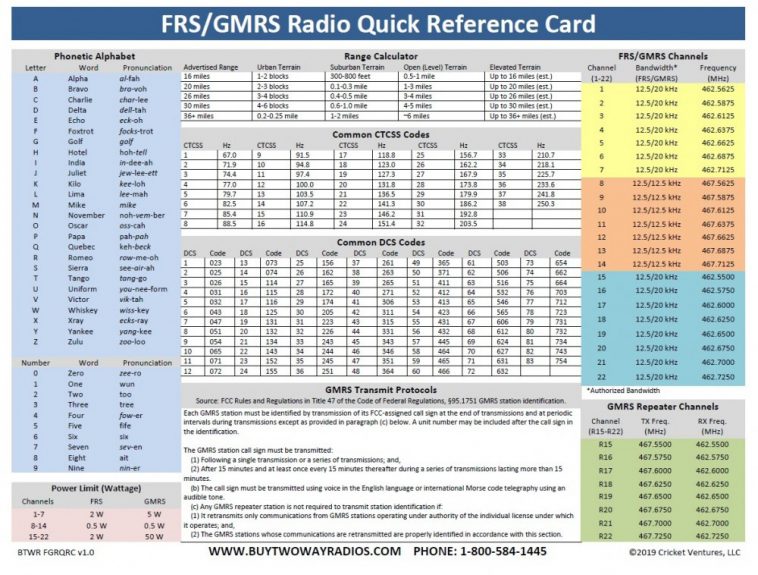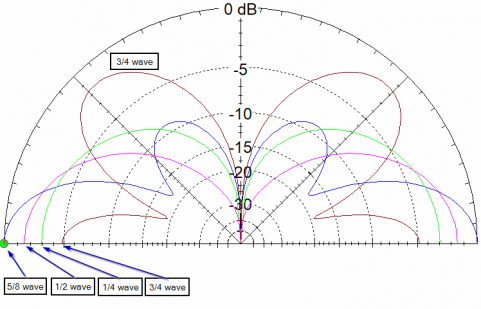GMRS stands for General Mobile Radio Service. It is a specific range of radio frequency channels in the UHF (Ultra High Frequency) spectrum, specifically 462Mhz to 467Mhz. An FCC (Federal Communications Commission) license is required to use GMRS, but unlike Amateur (Ham) Radio, a GMRS license from the FCC does not require a technical knowledge test. Functional knowledge along those lines can be acquired as you go. Many consider GMRS and Amateur Radio a good combination. Not GMRS licensed yet? You'll need a FRN (Federal Registration Number) and can get started here.
Over a period of many years, the license fee has declined from nearly $100 to the current $35 (good for ten years), fee which covers your entire family (Part 95.1705(c)(2) Any individual who holds an individual license m ay allow his or her immediate family members to operate his or her GMRS station or stations. Immediate family members are the licensee's spouse, children, grandchildren, stepchildren, parents, grandparents, stepparents, brothers, sisters, aunts, uncles, nieces, nephews, and in-laws).
With this license, you will be issued a callsign (ex WABC123) from the FCC that you must transmit for Identification, at time intervals specified in the rules, when using the system (Following a single transmission or a series of transmissions; and, After 15 minutes and at least once every 15 minutes thereafter during a series of transmissions lasting more than 15 minutes.) One unfortunate, but common, experience is that the FCC web site or the payment portal may be bogged down or delayed in issuing your official license (Govt shutdowns anyone?). If that happens during your application process, here is what we believe will be some helpful information.
Once you have successfully submitted your application (now an electronic version of Form 605), and paid the requisite fee, you can download, print out and sign Form 605 Schedule "F" which instantly authorizes your legal operation with a callsign of "WT" followed by your work or residence phone number (ex WT1234567). This was created years ago (at our request) when paper forms were still used (including weeks of processing time) and is still good for 90 days (which is more than enough time for on-line governmental processing).
As of September 16th, 2020 the FCC has transitioned away from paper filing and the mailing of licenses. Depending upon the day of the week you file (remember those holidays too) you can check on-line for your status in a few hours or a day or two.
FRS vs GMRS
FRS is the Family Radio Service, and it is another division of the radio spectrum offered by the FCC. FRS and GMRS actually share some of the same channels (frequencies), but FRS does not require a license. The "Bubble Pack" units you would find at Wal-Mart or other retailers are typically FRS radios. GMRS radios can communicate with FRS radios on the common channels.
So why GMRS over FRS?
This is a reasonable question. The two services are interoperable, to a degree, but your GMRS license, and your GMRS radio, is far more capable than any FRS radio. FRS radios are limited to 1/2 watt or 2 watts, depending on the channel. A great deal of FCC history is behind this situation, but that is a discussion for another day and venue. FRS radios are not capable of long distance communication via repeaters. GMRS radios, on the other hand, can range from 5 watts (handheld/"walkie talkie") to 50 watt mobile and repeater stations. Additionally, most antennae can provide some "gain" or increase in performance resulting in the perceived multiplication of output power. Repeater range distances can vary from as little as 5 miles in diameter to 150+ miles! Most FRS commercial advertising has somewhat exaggerated range claims (this is being extremely generous in analysis), occasionally stating up to 38 miles! In actual usage you might get a mile or so (if terrain conditions permit). GMRS radios can actually communicate many miles, and in ideal conditions, regularly achieve 60+ miles distance or more (from the repeater) with the aid of an elevated repeater, again depending upon your location and other conditions.
Displayed below is a Frequency Chart offered by BuyTwoWayRadios.com Get you own copy for Base or Mobile handy reference.

Relating to the channels/frequencies listed above there are a few restrictions that apply for those living in the northern U.S. near the Canadian border. Often referred to as "Line A" the details are here.
Want to start transmitting RIGHT NOW? If one is really "chomping at the bit" to get started, operating on GMRS, there IS a way to accelerate the process a bit.
The FCC usually processes a completed application (with the required fee payment having been made), in just a few hours to a few days, the applicant has the option to first submit FCC Form 605 (now done electronically) and then complete Schedule "F" which is locally retained. The Temporary callsign will be "WT" followed by the business or residence phone number of the applicant. This procedure was instituted in the late 70s or early 80s, but has been largely forgotten as the speed of license-granting has greatly accelerated. However, it is still "on the books".
System Design and Antennae.
Every properly functioning radio system (regardless of the radio service in which it may be operating) depends upon several factors; quality electronics, good power connections and a well-tuned antenna designed for the intended purpose. Typically, omni-directional antennae provide adequate general service, but some circumstances require more effective capacity. One example of a more-capable (directional) antennae is the "Yagi" (the full name is "Yagi-Uda") which was developed in Japan about 100 years ago! Some history of the inventors (gathered from the Internet) is posted here. Directional antennae do not actually generate more RF energy, but rather "focus" or "squeeze" the supplied energy into one particular direction. This is usually in a vertical polarization, but can be either V or H or even a "cross-field" with a "loop" style antennae oriented as a "diamond" relative to the earth's plane. A mobile gain antenna does something similar, but the "squeeze" is done in the vertical plane. To visualize this scenario, imagine a doughnut lying on its side with very little energy leaving the "hole" via the top and bottom. The "squeeze" flattens the doughnut and concentrates the RF energy in this plane. One critical concern about mobile gain antennae depends upon where one desires the signal to go. Simplex communication, or duplex where the repeater is NOT on greatly elevated ground, may be enhanced by the "squeeze." However, if the repeater is elevated, then reducing RF in an "upwards" orientation will degrade your reach. Below is an image to help display how vertical signal strength can vary based upon antennae design. Sourced from: https://practicalantennas.com/designs/verticals/5eights/

Net Activation in the Region
If any local (western Washington State) operators are interested in opportunities to listen, learn or participate in GMRS radio "Nets" being held in the area, there are several that occur on East Tiger (Oly-Comm3) and elsewhere. If there are additional Nets (or details) that should be listed or corrected here, please advise and we will update.
East Tiger: Tuesday at 19:30 (Technical), Wednesday at 20:00 (Greater Maple Valley C.E.R.T. Net), Thursday at 19:30 (Social Net) and Friday at 20:00 (Ham Study Sessions).
Outlook Mountain: Tuesdays at 19:00 (Communications Prep Net).
Gold Mountain: Saturday at 18:00 (Social Net).
Oly-Comm1 (Discovery Bay): Broadcast News-Gathering Stringers & EMCOMM Volunteers in Various Communities (TBA).
Additional background information on the General Mobile Radio Service is available here.